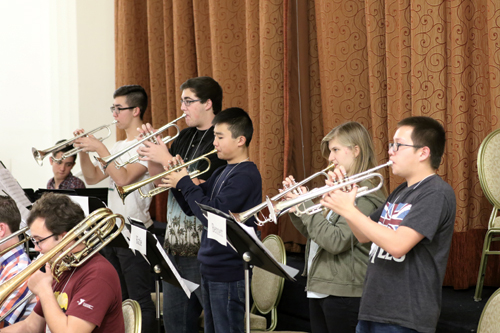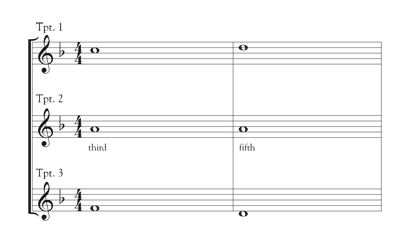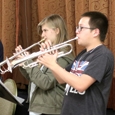
If I were putting a concert band trumpet section together, and I had three trumpet parts and nine players, I would take the three best players and put one on first, one on second, and one on third. The next three players would be second chair for each part, the bottom three would also be split that way.
.jpg)
If all the best players are on the first part, the only thing the last-chair third trumpet will hear is someone marginally better. There will never be anyone to suggest pushing the third valve slide out when playing a low D or Db. It might be a few chairs up before someone knows to do that. Seating students with the three best players split gives each part a section leader and makes mentors available to every student. I wish I had a good player sitting next to me when I played third trumpet as a freshman in high school. I sat next to students who never practiced, and it did not inspire me to play more.
If players have a great upperclassman sitting next to them, they will be motivated to show up with their music learned. It benefits everyone in many different ways. It inspires people to practice more, be more serious in rehearsal, and talk less. People sit up straighter and kick up their intensity with a strong player next to them.
It may be that the third-best player will be unhappy about playing third trumpet, but if he hears how much of a difference it makes, it becomes clearer why a strong third player is needed. Bugler’s Holiday is a perfect example of why a strong player on a third part is so important. Double tonguing, tight ensemble work, and intonation are all key for making sure it does not become Bugler’s Disaster. Give a strong player on third trumpet the responsibility to make sure that the thirds are all together.
Each Part’s Role
My teacher from Oberlin talked about how great George Szell made the Cleveland Orchestra. Szell made the orchestra play as if it were a string quartet, meaning the orchestra members were playing and listening together. When considering a quartet, everything is clear and precise, and everyone has a specific role and knows it well. The Cleveland Orchestra captured that well. There were 20 first violins and 20 second violins, but players knew their roles and who and what to listen to at all times. The same should be true within a section or small ensemble. There are specific roles that each section member plays to help create the section.
First Trumpet
First trumpet in an orchestra or concert band is usually considered the head of the brass section, and this is generally how most composers and arrangers write. The first trumpet player’s primary responsibility is consistency. Students usually think range and volume matter most for first trumpet, but a player with a beautiful, consistent sound is the ideal choice for section leader.
In addition to being consistent, the first trumpet player must play musically and communicate effectively with the section. The section leader must be able to listen to what everyone in the section is doing and communicate how to play parts, both by example and vocally. The first player sets the style, volume, and articulations that shape the music. The first trumpet player also has a larger responsibility to watch the conductor for cues, which dictate what is allowed stylistically. Section leaders should also make notes of any conductor feedback on volume, style, and articulation.
The first trumpet in a big band has similar responsibilities. The styles will be different, the range will be a fourth or fifth higher, and the sound concept is brighter, but the need for consistency and clear directions is the same. The lead trumpet player listens to everything, but especially the bass, which gives the harmonic time, and the drums, which gives style, time, and feel. The lead trumpet also listens to first trombone and lead alto. The first players in each section should work on playing together, and then each section fans out from its lead player. While someone has to hit the high notes, the player with the largest range is not always the best lead trumpet.
Second Trumpet
Second trumpet in an orchestra and concert band is the most difficult chair to play. The second part requires excellent ears – sometimes even better than it takes to be a first trumpet player. Everyone can sing an easy melody, but if you ask people to sing an inner harmony for a tune, most will be lost. A harmony part will not necessarily sound melodic, and it is a difficult to take a non-melodic line and play it melodically.
The second player is an inner voice whose focus should be supporting the first player, with solid intonation and appropriate volume; the second part should not overshadow what the first player plays. Playing inner voices means adjusting from note to note and listening carefully for changes in the harmony and musical texture. You could be playing the same note, but if the harmonies change, the intonation of that note will have to be adjusted.

In a jazz band, second trumpet is generally the solo chair. This comes with different responsibilities than the first part, primarily improvisation. I think it is great to make everyone play solos. Allowing all of the players opportunities to take solos will help with playing more confidently, and will help developing players gain confidence and experience for the future.
Third Trumpet
Third trumpet parts in concert band or orchestra often consist of further harmonies within the trumpet section or with the trombones or horns. Third players should usually be coached to listen to and support the second trumpets, but occasionally, the thirds will double the first part an octave lower.
In a big band, the third voice can be the most awkward to play. The third part might cover harmonies that do not come to the ears naturally. Playing third trumpet for Benny Goodman or Count Basie charts is difficult reading because the notes sound strange on their own and are so far away from the melody that it can be difficult for students to take them seriously. I suggest to third part players that they consider their line as part of the whole. Third trumpet makes sense in the context of the second part and then the first. It is like a puzzle; you see where your piece fits. It fills up the section and adds fullness to the chords.
Fourth Trumpet
Fourth trumpet parts are rare in a concert band but common in a big band. The fourth trumpet in a big band supports the third, playing the parts of chords that are left, and will likely also double another part. I have played a number of big band charts in which the fourth trumpet plays even when the other trumpets do not, because the part is added to the trombone section or placed with the tenor saxophones.
Intonation Is Key
Lin Biviano, who played lead trumpet with Buddy Rich and Count Basie, taught me that even the best first trumpet player would sound bad if the supporting players were out of tune or out of sync. In the professional world, a second or third trumpet player can easily get a first trumpet player fired simply by pushing in his tuning slide a quarter inch. That is how important the lower parts are. Poor intonation lower in the section can really mess with the first part. If one part of a chord is off, the whole thing will sound wrong, and the first player will chip every note because the harmonies stacked up below are in the wrong spot. You cannot shut off what you hear. This is especially true on a brass instrument, where you have to hear the note in your head before you play it. It does not matter how good a player is; few things will wear out a lead trumpet player as quickly as an out-of-tune section. Conversely, an average lead trumpet player in a section where everyone plays together and supports each other will sound amazing. When students understand that their playing affects the entire section, everyone takes their music and their intonation more seriously.
Octaves
When a composer writes an octave, it is there for a reason and should sound correct. When an octave is top heavy, it is less impressive than when it is balanced, but to balance octaves, the bottom voice should be twice as loud. The bottom on an octave is the foundation which provides a cushion for the top octave to sit. The upper octave should feel like it is being carried by the bottom one.
The lower one plays, the more likely it is that the instrument is longer than the player up an octave (compare fingerings for written D4 and D5). The greater length of tubing often places lower voices behind the time, as the response is not as immediate when dealing with the lower voices. So the lower voices must pay extra attention to stay perfectly in time.
Intonation is particularly noticeable in octaves. If the bottom octave is sharp, it will push the top octave up. If the bottom is flat, it will drag the top part down. They are linked. A sharp third trumpet player will ruin the first player’s chops as he tries to lip up to be in tune with the lower octave.
Vibrato
When playing in a section, vibrato can destabilize everything, so inner voices should use less or none at all. This is especially true in orchestral playing. Few players think to address whether and how much vibrato to use within the section. It is a small detail, but it makes a big difference. You cannot have half the section using vibrato. It is appropriate in certain settings, such as jazz from the 1920s and 30s.
Section Unity
Breathing together as a section is important. Players who breathe together come in together. This is a good section exercise for breathing and coming in together:

This helps teach students to listen across for the breath and articulations. It also bridges the gap between playing with time and playing in time. A student can play with time and be consistent but still sound separate from everyone else. However, playing in time means that everyone is together and beat one lands in the same spot for everybody. If the breath is the same for everyone, then the note will be the same for everyone.
Another excellent section-building exercise is learning the other parts. Few people take the time to look at the parts of the people sitting next to them. After students have learned their parts, spend a rehearsal rotating the chairs. Play through a section of the music, then have everyone switch seats, so the firsts are now sitting where the thirds were and reading the third part. Seconds move to first, and thirds move to second. Play through the section, then rotate seats again. Give everyone the opportunity to play all three (or four parts) so everyone discovers what is happening in the section. It is better to move chairs than swap parts because then the parts are heard from the usual place. Directors might shy away from this if they have students who can barely play their own parts, but if it is a week before the concert and the ensemble is polishing things, try it for a day, and then end rehearsal with a run-through where everyone plays their original part.
When people understand what others are playing and what their part supports, then the section comes alive. Switching parts shows younger students what to listen for. It may be that some students cannot handle some aspect of a first part, but give it to them anyway. Let them try. It gives students a taste of what the first part is going to be like and can be a motivator to work harder.
I had the opportunity to sit in on a number of Cleveland Orchestra rehearsals while studying at Oberlin. I remember seeing principal trumpet Michael Sachs reading the score to the symphony during rehearsal. When not playing, he was looking at the other parts, trying to understand them better. It was part of what made him such a great player – he played every part in his mind.






